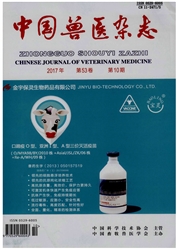

 中文摘要:
中文摘要:
为研究小型猪特异性麻醉颉颃剂对麻醉大鼠不同脑区β-内啡肽(β-EP)含量的影响,应用小型猪特异性麻醉颉颃剂分别于早期(麻醉后10min)、中期(麻醉后30 min)、晚期(麻醉后60min)催醒XFM麻醉下大鼠.断头取脑后,采用ELISA方法检测大脑皮层、海马、丘脑、小脑、脑干内β-内啡肽的含量变化.结果显示,苏醒过程中恢复直线爬行时脑内β-内啡肽含量高于恢复翻正反射即刻,呈现升高趋势;早期试验组海马、脑干,中期催醒试验组海马、丘脑、小脑、脑干内β-EP含量恢复翻正反射时显著低于对照组(P<0.05),由此推断小型猪特异性麻醉颉颃剂可能是通过减少脑中β-EP含量,降低XFM对中枢神经的抑制作用,缩短小型猪苏醒时间,这可能是小型猪特异性麻醉颉颃剂产生催醒作用的机制之一.
 英文摘要:
英文摘要:
To study the effect of the specific antagonist for miniature pigs' combined anaesthetic on β-EP eontents in difrerent encephalic regions, 96 rats were injected by the specific antagonist for miniature pigs' combined anaesthetic after anesthetizing 10 rain, 30rain and 60min separately. The β-EP contents were measured by Enzyme-Linked Immunosorhent Assay(ELISA). The results showed that the β-EP contents in each group were higher at the moment of rectilinear creeping than at the moment of recovering body-right reflex (P 〈0.05); The β-EP contents in the early experimental groups was lower than in the controls at the moment of re- covering body-right reflex in the brain stem and hippocampus regions (P 〈0.05). The β-EP contents in the middle experimental groups was also lower than that of controls at the moment of recovering body-right reflex in the brain stem, thalamus, cerebellum and hippoeampus regions (P 〈0.05). It was concluded that the specific antagonist for miniature pigs' combined anaesthetic took effects on arousing by reducing the β-EP contents. This might be one of the mechanism for the specific antagonist tor miniature pigs' com- bined anaesthetic.
 同期刊论文项目
同期刊论文项目
 同项目期刊论文
同项目期刊论文
 Antagonistic effect of atipamezole, flumazenil and naloxone against anaesthesia with xylazine, trama
Antagonistic effect of atipamezole, flumazenil and naloxone against anaesthesia with xylazine, trama 期刊信息
期刊信息
